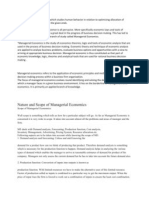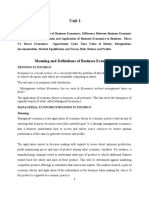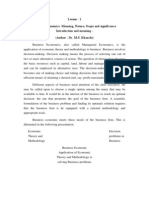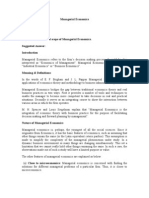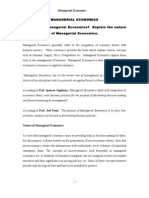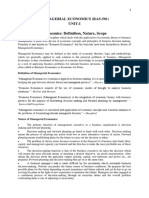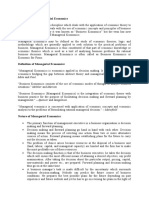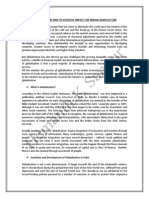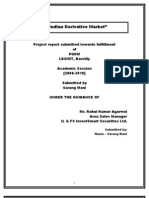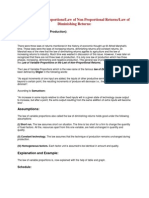Me 4
Me 4
Uploaded by
muralib4u5Copyright:
Available Formats
Me 4
Me 4
Uploaded by
muralib4u5Original Description:
Original Title
Copyright
Available Formats
Share this document
Did you find this document useful?
Is this content inappropriate?
Copyright:
Available Formats
Me 4
Me 4
Uploaded by
muralib4u5Copyright:
Available Formats
1
Managerial Economics
Q1. What is Managerial Economics? Explain the nature and scope of Managerial Economics.
Ans. Managerial Economics generally refers to the integration of economic theory with business
practice. While economics provides the tools which explain various concepts such as Demand,
Supply, Price, Competition etc., Managerial Economics applies these tools to the management of
business. In this sense, Managerial Economics is also understood to refer to business economics
or applied economics.
Definitions of Managerial Economics
According to Prof. Spencer Sigelman, Managerial Economics deals with integration of economic
theory with business practice for the purpose of facilitating decision making and forward planning
by management.
According to Prof. Hauge, Managerial Economics is concerned with using logic of economics,
mathematics & statistics to provide effective ways of thinking about business decision problems.
According to Prof. Joel Dean, The purpose of Managerial Economics is to show how economic
analysis can be used in formulating business policies.
Nature of Managerial Economics:
1. Managerial Economics aims at providing help in decision-making by firms. For this purpose,
it draws heavily on the propositions of microeconomic theory. The concepts of
microeconomics used frequently in managerial economics are marginal cost, marginal
revenue, elasticity of demand, market structures and their significance in pricing policies, etc.
Some of these concepts however provide only the logical base and have to be modified in
practice.
2. Macroeconomics assists firms in forecasting. Macroeconomics indicates the relationship
between (i) the magnitude of investments and level of national income, (ii) the level of
national income and the level of employment, (iii) the level of consumption and the national
income, etc. The postulates of macro economics can be used to identify the level of demand
at some future point of time, based on the relationship between the level of national income
and the demand for a particular product.
3. Managerial Economics is decidedly applied branch of knowledge. Therefore, the emphasis is
laid on these propositions which are likely to be useful to the management.
4. Managerial Economics is prescriptive in nature and character. It recommends that it should
be done under alternative conditions. Thus, managerial economics is one of the normative
sciences and reflects upon the desirability or otherwise of the propositions.
5. Managerial Economics, to the extent that it uses economic thought, is a science, but it is an
applied science. Economic thought uses deductive logic (if X is true, then Y is true.) To have
confidence in the findings, the propositions deducted are subjected to empirical verification.
Furthermore, there is an attempt to generalize the propositions which provide a predictive
character.
Scope of Managerial Economics
The scope of Managerial Economics is so wide that it embraces almost all the problems and areas
of the manager and the firm. It deals with demand analysis and forecasting, resource allocation,
production function, cost analysis, inventory management , advertising, price system, capital
budgeting etc.
1. Demand Analysis and forecasting: It analyses carefully and systematically the various
types of demand which enable the manager to arrive at a reasonable estimate of demand for
2
products of his company. He takes into account such concepts as income elasticity and cross
elasticity. When demand is estimated, the manager does not stop at the stage of assessing the
current demand but estimates future demand as well. This is what is meant by demand
forecasting.
2. Production Function: The resources are scarce and also have alternative uses. Inputs
play a vital role in the economics of production. The factors of production, otherwise called
inputs, may be combined in a particular way to yield the maximum output. Alternatively,
when the price of inputs shoot up, a firm is forced to work out a combination of inputs so as to
ensure that this combination becomes least cost combination. In this way, the production
function is pressed into service by managerial economics.
3. Cost Analysis: Cost analysis is yet another area studied by managerial economics. For
instance, determinants of cost, methods of estimating costs, the relationship between cost and
output, the forecast of cost and profit these are very vital to a firm. Managerial Economics
touches these aspects of cost-analysis, an effective knowledge and application of which is
cornerstone for the success of a firm.
4. Inventory Management: An inventory refers to stock of raw materials which a firm
keeps. Now the problem is how much of the inventory is ideal stock. If it is high, capital is
unproductively tied up, which might, if the stock of inventory is reduced, be used for other
productive purposes. On the other hand, if level of inventory is low, production will be
hampered. Therefore, managerial economics will use such methods as ABC analysis, a
simple simulation exercise and some mathematical models with a view to minimize the
inventory cost. It also goes deeper into such aspects as the need for inventory control; It
classifies inventories and discusses the costs of carrying them.
5. Advertising: It may sound strange when we say that advertising is an area which managerial
economics embraces. While the copy, illustration, etc. of an advertisement are the
responsibility of those who get it ready for the press, the problems of cost, the methods of
determining the total advertisement costs and budget, the measuring of the economic effects
of advertising these are the problems of the manager. To produce a commodity is one thing;
to market it is another. Yet the message about the product should reach the consumer before
he thinks of buying it. Therefore advertising forms an integral part of decision-making and
forward planning.
6. Price System: The pricing system as a concept was developed by economics and it is
widely used in managerial economics. The central functions of an enterprise are not only
production but pricing as well. While the cost of production has to be taken into account
while pricing a commodity, a complete knowledge of the price system is quite essential to
determination of price. Pricing is actually guided by considerations of cost plus pricing and
the policies of public enterprises. Further, there is such a thing as price leadership and non-
price competition. Price system touches upon several aspects of managerial economics and
aids or guides the manger to take valid and profitable decisions.
7. Resource Allocation: Scarce resources obviously have alternate uses. How best can these
scarce resources be allocated to competing needs? The aim of course is to achieve
optimization. For this purpose some advanced tools like linear programming are used to
arrive at the best course of action for a specified end.
8. Capital Budgeting: This is another area which calls for a thorough understanding on the
part of the manager if he is to arrive at meaningful decisions. Capital is scarce, and it costs
something. Now the problem is how to arrive at the cost of capital; how to ensure that capital
becomes rational; how to face up to budgeting problems; how to arrive at investment
decisions under conditions of uncertainty; how to effect a cost-benefit analysis.
Q2. What is a joint stock company? Explain the merits and demerits of a joint stock company.
Ans. In the word of Mr. Kuchhal, a joint-stock company is an incorporated association which is an
artificial legal person, having independent legal identity, with a perpetual succession, a carrying a
limited liability.
3
As per the Indian Companies Act, 1956, a joint stock company is a company which has a
permanent paid up or nominal share capital or a fixed amount if capital divided into shares held
and transferable as stock by shareholders who are its members.
Thus a joint stock company is a voluntary incorporated association of shareholders or stockholders
who contribute to the common stock, of which they are the owners. But all of them do not directly
manage it. It is managed by some directors elected by shareholders. Their liability is limited to
the value of shares held by them. They share in profits and losses.
Merits of Joint stock company
1. Limited Liability: The principle of limited liability is applicable to a joint-stock company.
Since the liability of shareholders is limited, risk faced by them are reduced. Hence even if a
company suffers losses, they need not pay more than the face value of shares purchased by
them. So the creditors of the company have no private property. Hence people are induced to
invest their money in such companies.
2. Large amount of capital: Large-scale production is facilitated under the company form
of business organization. This is because it is easy for a company to raise a large amount of
capital, by acceptive fixed deposits from the public. Thus the savings of the people can be
productively used.
3. Transfer of shares: The shares of a company are transferable whenever one likes. Hence it
would encourage small savers to invest in the shares of companies. If they do not like to keep
their funds in a particular company, they would be free to sell their shares on stock exchange
and invest in some other companies. Thus the money of a share holder is not blocked. At the
same time, this does not affect the company in any way. This is because the sales of shares of
a company by some are counterbalanced by the purchase of these shares on a stock exchange
by others.
4. Shares of different varieties: The shares of a company are of different types, namely, equity
shares, simple preference shares, cumulative preference shares etc. The equity shares may be
purchased by people who want to take greater risks. On the other hand, those who do not
want to take any risk may invest in cumulative preference shares. Thus, by providing a wide
choice to share holders, it is possible for a company to raise a large amount of capital.
5. Risky enterprises: A joint stock company can start a risky enterprise. This is because the
risks associated with a business are greatly reduced due to the limited liability of share holders
and a small value of the shares of each chare holder. Further an individual may purchase
shares of different companies so as to minimize the loss still further. So even if there is a loss
in the case of one company, the individual shareholders may not be affected much.
6. Less danger of misappropriation of funds: There is a less danger of misappropriation of
funds. This is because the audited accounts of the companies must be published.
7. Combination of capital and business abilities: Many individuals possessing a large amount
of capital and not having capacities to start and run a business can invest in companies. Other
persons, having no capital but possessing capacities to manage a business, can secure jobs as
managers and executives in companies.
8. Efficient management: In a joint stock company, the ownership and management are
separated. The share holders are owners but they do not manage it. It is managed by experts
in different fields, who work under the direction of the Board of Directors.
9. Economies of Scale: A joint stock company can enjoy the economies of scale such as
advantages of specialization and division of labour etc. by making full use of managerial
skills and abilities and other factors of production.
10. Continuity and stability: Since it has a perpetual succession, a company continues to
carry on its business even if some of the original shareholders leave the company or die or
become insolvent. So it is permanent and stable in nature. So the business activities can be
undertaken with a long term objective.
11. Legal Control: Since companies are subject to rules and regulations of the Companies
Act, 1956, they are supposed to work in the interest of their shareholders.
4
12. Democratic management: There is democratic management in a joint stock company.
This is because the directors are elected by shareholders from time to time. The elected board
of directors manage the company successfully because of their wide experience, abilities and
efficiencies.
13. Research: Because of its continuous existence and a large amount of resources at its
disposal, a company can conduct research and experiments, and apply the fruits of research to
industrial uses. This will enable it to improve the quality of its product, reduce its cost of
production and thereby enjoy good profits in due course.
Demerits of Joint stock Companies
1. Lack of personal interest and inefficient management: The actual management of a joint
stock company is the hands of salaried executives. They have no personal interest in the
functioning of their company. Hence they may not always manage the affairs of their
company efficiently. Some of them may even leak out secrets of their company to rival
companies.
2. Indifference of shareholders and oligarchy: On account of their limited liability, many of
the shareholders are indifferent. They may not take an active part in the affairs of their
company. They are also scattered. They are interested only in dividend. So a few big
shareholders manage to get directorships and take all decisions. So, in actual life, there is
oligarchy rather than democracy in the management of a company. Further these few
directors manage to remain in power by some means or the other and enjoy vast powers of
management and decision-making. So shareholders are owners only in name.
3. Promotion of self-indirect and misuse of power by directors: A few big directors, who
control the affairs of the company, try to promote their own interests in various ways at the
cost of other shareholders. Further when the directors are dishonest, they may commit some
frauds and cheat and exploit the shareholders. They may also purchase inputs from their
friends and relatives at high prices and resort to other corrupt practices. They may also claim
excessive fees.
4. Too risky ventures: The directors may be inclined to start very risky enterprises which may
fail. Hence they will involve the shareholders in losses
5. Extravagance: The directors may not behave in a responsible manner. They may
spend in an extravagant way.
6. Favoritism: The selection of the staff to work in various departments may not be made by
directors or managers on the basis of merit, but on the basis of favoritism, influence, personal
relations etc. They may employ their friends and relatives in high posts paying high salaries.
Hence the general working of a company is likely to suffer.
7. Unethical Practices: Directors possess inside information of the working of their company.
Hence they may dispose off their shares at high prices by creating an impression that their
company is going to make good profits when, in fact, the things are otherwise. So those who
buy such shares will suffer losses. In the opposite case, when a company is likely to make
good profits, they may try to create an impression that it would suffer losses. This impression
will induce other shareholders to sell their shares. They buy them through their agents.
Hence they can get all the profits for themselves. The transferability and marketability of
shares is also responsible for unhealthy speculative activities on stock exchanges on the part
of some directors. As a result, the interest of shareholders are ignored with the result that a
large number of them may be ruined.
8. Conflict: There is no close personal contact between employees and management. Hence
there is likely to be a conflict between employees and the management. At times, this may
result in strikes and lockouts. So the companys output would suffer causing thereby a loss to
the shareholders.
9. Political Corruption: A number of joint stock companies may pay a large amount of money
as donations to political parties. They are given for the personal benefit of directors and/or for
the benefit of the company at the cost of the public.
10. Concentration of Economic Power and Wealth and Inefficient management: Most of the
important companies in a country are dominated by a few wealthy individuals. As they are
elected as directors, there would be a concentration of wealth and economic power in their
5
hands. They manage to get themselves re-elected by some means or the other. However such
people may lack adequate experience and skill. Hence they may not be in a position to
manage the affairs of the company efficiently.
11. Delay in taking decisions: The Board of Directors of a joint stock company cannot take
quick decisions and prompt action to meet the changes in demand for its product. This is
because there is a lot of discussion and consultation before taking any decision. This causes
unnecessary delay. Hence when quick decision and prompt action are required, a company
for of organization is not suitable as a partnership concern or even a private proprietorship
concern.
Q3. Explain the basic problems that are faced by various types of economies.
Ans. The problem of economy is how to use the relatively limited resources with alternative uses in the
face of unlimited wants. Naturally, everyone will so try to use his relatively limited resources
with alternative uses that he gets maximum satisfaction out of his resources. In view of limited
resources and unlimited wants, he will try to satisfy those wants which are most urgent or intense
and then those wants slightly less urgent and so on thus sacrificing the satisfaction of those wants
which are lower on the scale of preference for which he may not have the resources. This is the
problem of economy how to make the maximum use of limited resources.
The seven basic economic problems that must be faced in all economies, whether they be
capitalist, socialist or communist, and mixed are being explained as under:
1. What commodities are being produced and in what quantities? This question arises
directly out of the scarcity of resources. It concerns the allocation of scarce resources among
alternative uses. The question What determines the allocation of resources? have occupied
economists since the earliest days of the subject. In free market economies, most decisions
concerning the allocation of resources are made through the price system.
2. By what methods are these commodities produced? This question arises because there
is almost always more than one technically possible way in which goods and services can be
produced. Agricultural goods, for example, can be produced by farming a small quantity of
land very intensively, using large quantities of fertilizer labour and machinery, or farming a
large quantity of land extensively, using only small quantities of fertilizer, labour and
machinery. Both methods can be used to produce the same quantity of some good; one
method is frugal with land but uses larger quantities of other resources, whereas the other
method uses large quantities of land but is frugal in its use of other resources. The same is
true of manufactured goods; it is usually possible to produce the same output by several
different techniques, ranging from one using a large quantity of labour and only a few simple
machines to ones using a large quantity of highly automated machines rather than another.
3. How is societys output of goods and services divided among its members? Why can some
individuals and groups consume a large share of the national output while other individuals
and groups can consume only a small share? The superficial answer is because the former
earn large incomes while the latter earn small incomes. But this only pushes the question one
stage back. Why do some individuals and groups earn large incomes while others earn only
small incomes? Economists wish to know why any particular division occurs in a free market
society and what forces, including government intervention, can cause it to change.
4. How efficient is the societys production and distribution? This question quite
naturally arises out of problem 1,2 and 3. Having asked what quantities of goods are
produced, how they are produced and to whom they are distributed, it is natural to go on to
ask whether the production and distribution decisions are efficient. The concept of efficiency
is quite distinct from the concept of justice. The latter is a normative concept, and a just
distribution of the national product would be one that our value judgements told us was a
good or a desirable distribution. Efficiency and inefficiency are positive concepts.
Production is said to be inefficient if it would be possible to produce more of at least one
commodity without simultaneously producing less of any other by merely reallocating
resources. The commodities that are produced are said to be inefficiently distributed if it
6
would be possible to redistribute them among the individuals in the society and make at least
one person better off without simultaneously making anyone worse off.
5. Are the countrys resources being fully utilized: The existing resources of any
country are not sufficient to satisfy even the most pressing needs of all the individual
consumers. Surely if resources are so scarce that there are not enough of them to produce all
of those commodities which are urgently required, there can be no question of leaving idle
any of the resources that are available. Yet one of the most disturbing characteristics of free
market economies is that such waste sometimes occurs. When this happens the resources are
said to be involuntarily unemployed. Unemployed workers would like to have jobs, the
factories in which they could work are available, the managers and owners would like to be
able to operate their factories, raw materials are available in abundance, and the good that
could be produced by these resources are urgently required by individuals in the community.
Yet, for some reason, nothing happens: the workers stay unemployed, the factories lie idle and
the raw materials remain unused. The cost of such periods of unemployment is felt both in
terms of the goods and services that could have been produced by the idle resources, and in
terms of the effects on people who are unable to find work for prolonged periods of time.
6. Is the purchasing power of money and savings constant, or is it being eroded because of
inflation? The worlds economies have often experienced periods of prolonged and rapid
changes in price levels. Over the long swing of history, price levels have sometimes risen and
sometimes fallen. Inflation reduces the purchasing power of money and savings. It is closely
related to the amount of money in the economy. Money is the invention of human beings, not
of nature, and the amount in existence can be controlled by them.
7. Is the economys capacity to produce goods and services growing from year to year or is
it remaining static? Why the capacity to produce grows rapidly in some economies, slowly
in others, and not at all in yet others is a critical problem which has exercised the minds of
some of the best economists since the time of Adam Smith.
Q4. Explain the features of public sector enterprises. Point out their merits and demerits.
Ans. The public enterprises refer to enterprises which are owned, managed and controlled by the
government. They are called state enterprises or public undertakings They include radio,
river projects, basic and key industries, various public utility undertakings providing railway
transport, road transport, water, electricity, gas, etc.
The main features of Public enterprises are:
1. State Control: They are owned, managed and controlled by the concerned departments
of the government or by the government bodies.
2. Management: Some of them may be managed by professionals.
3. Accountability: They are accountable to the public because they are accountable to the
government which represents the people.
4. Separate Funds: They are assigned separate funds to undertake their activities.
5. Legal Status: Each public enterprises is a separate legal entity, for it is established by
law. Some of the public enterprises enjoy autonomous status operating as per the state policy
and general directives from the government. So they are influenced more by the state policy
than the enterprises in the private sector.
6. Profit: Some of them may work for promoting welfare of the people rather than making
profits. Some of them are run on commercial principle so as to make profits. But profit-
making is not their main motive for, at the same time, they have to promote social ends.
Merits of Public Enterprises:
1. Use of profit: Some of the public enterprises like post and telegraphs are not run for
earning profit while other enterprises like Hindustan Machine Tools as in India are run for
making profits. But the profits earned by them are utilized for improving services rendered or
7
for further expansion of their activities. Thus profits earned by State enterprises can be used
to promote general welfare.
2. Nature of Investment: There are certain fields in which the private sector will not
invest either because the yield on such investment is too low and spread over a very long
period. The government has, therefore, to undertake such investment in the interest of
society.
3. Sufficient capital: It is also quiet likely that the private sector may not be in a position to
raise enough capital for a project or an industry. But the government can raise any amount of
capital from various sources for investment in any project or an industry. Hence such projects
or industries are started in the public sector.
4. Public welfare: In certain fields, the state enterprises may work more efficiently than
private enterprises. This is particularly the case with public utility services. If they are left to
the private sector, the consumers may be exploited. Hence they are organized by the
government on the monopoly basis to secure economies of scale.
5. Economies of large scale production: On account of large scale production, they can enjoy
the economies of large scale production.
6. Consumer Interests and Quality of Goods: As compared with the private sector
enterprises, the quality of goods or services provided by the public enterprises is likely to be
better. They will also be made available at reasonable enterprises. Hence the interests of
consumers would be safeguarded.
7. Labour relations: The scope for conflicts between workers and the public enterprises
would be minimum. This is because the workers are likely to be more contented due to
security and justice in service.
8. Industrial Development: When a country has a few entrepreneurs and the skilled labor
is limited. The government may set up a number of industries by inviting foreign skilled
labour to help it to accelerate the pace of industrial development. It may also attract very
efficient personnel and best managerial talent by offering high salaries and better service
conditions.
9. No wastes: All wastes of economic resources in the form of existence of excess capacity in
the private sector industries, competitive advertisement etc. can be eliminated if they are
nationalized and run by the government.
10. Check on the concentration of Economic Power and Private Monopoly: The public
enterprises can help to check the concentration of economic power in the hands of a few
individual and the growth of private monopolies.
11. Balanced Development: They can contribute to a balanced regional development by
locating public enterprises in less developed areas and thereby reduce the regional income
inequalities.
12. Ultimate control by People: The working of the public enterprises is subject to the
criticism of the people and the members of the parliament. Hence, if there is anything wrong
in the working of the public enterprises, it would be set right. So the public enterprises are
ultimately controlled by the people themselves.
Demerits of Public enterprises
1. Inefficient Management: The government officials may take a lion time in taking
decisions as well as action. Hence the government enterprises may be run with excessive
social cost of operation. This may be so because all of them may not possess much business
experience.
2. No incentive for hard work: The public enterprises may not create incentives for hard work
for their workers. The mangers may not take any risk. This is because their acts are
questioned.
3. Bureaucracy and Red-tapism: Bureaucracy, red tapism and corruption may obstruct
the growth of public enterprises. The bureaucrats may not take quick action because they
have followed the established procedures. Hence they may cause losses to the public
enterprises. This would involve a burden to the taxpayers.
8
4. Lack of Incentives: Because of lack of incentives, personal initiative may be
lacking and the responsibilities may be avoided. This is because the government officials
may work in a routine way. In other words, they may not work enthusiastically and
efficiently.
5. Extravagance: The officials in charge of managing these enterprises may plan in a big
way and spend extravagantly. This would cause much loss to the public sector year after
year. Nobody may feel if there are losses.
6. Friction: They may also be an internal friction between various officials in a public
enterprise. Hence its efficiency would suffer.
7. Political Considerations: Political considerations may determine appointments, transfers
and promotions. Hence right man may not be placed in the right place. Such a policy is
detrimental to the efficient working of the public enterprises. Further bribery and corruption
may predominate. Also an enterprise may be located in a particular area out of the political
rather than economic considerations.
8. Rigidity: There may be rigidity in the working of the public sector enterprises due to strict
rules and regulations.
9. Transfers: There might be frequent transfers of the government officials. This would
disturb the smooth working of the government enterprises.
10. Helplessness of consumers: Individual consumers will be helpless when goods and
services are provided by big public enterprises. They may not much care for the public. They
may not get proper treatment from the officers in the public enterprises.
11. Unfair competition: Public enterprises, in a industry where private firms also function, may
offer unfair competition to private firms. Hence they may be helpless in the presence of the
government enterprises in the same field.
12. Personal liberty: Extension of the public sector may result in centralization of powers
and a loss of personal liberty. Also it may reduce resources available for investment in the
private sector. Hence the working to the private sector industries would suffer.
13. Government interference: Due to too much interference from the government the
executives in charge of the public enterprises may not take their own decisions to run them
properly.
14. Workers Interests: The workers interests may not always be protected resulting in labour
unrest. However the authorities may, sometimes, yield to the pressure of workers demand
due to the political considerations.
15. Prices: The public enterprises may go on increasing prices of their goods and services
periodically. This would result in a decline in the welfare of the people.
Q2. Briefly review various theories of profit.
Ans. Various theories have been developed to explain the emergence of profit.
1. Risk Taking theory: The Risk-Taking Theory was developed by the American economist
Hawley. According to him, profit arises because considerable amount of risk is involved in
business. Profit is therefore the reward for risk-taking. Hawleys theory has been criticized
on several grounds. In the first place, Hawley has not classified the types of risks. Secondly,
as Cawer has pointed out, profit is not the reward for risk-taking. It is the reward for risk-
avoiding. An entrepreneur is required to minimize his risk if he cannot eliminate it totally. A
successful entrepreneur is he who earns good profits by eliminating the risk. On the other
hand, a mediocre businessman is not able to reduce the risk in business; and therefore is
subjected to losses.
2. Uncertainty-Bearing Theory of profit: Uncertainty-Bearing Theory of profit was
developed by the American economist, Prof. F.H.Knight. He has classified the risks under the
two heads.
Certain risks such as risk of fire, risk of theft, risk of accident etc. are less important
because they can be passed on to an insurance company. An entrepreneur can take an
9
insurance policy by paying the premium. Since such risks are covered by insurance,
they are called Insurable Risks.
There are other risks which cannot be passed on to an insurance company or to the paid
managers. Every business involves great amount of uncertainty and the losses arising
therefrom cannot be estimated with precision. The prices of raw materials may
suddenly increase, the supply of raw materials may be restricted and introduction of
new substitutes in the market may reduce the demand for the product. When demand
declines, large stocks may remain unsold in the go-down. A producer may have to face
keen competition, if the market is characterized by monopolistic competition. All
these factors are uncertain and losses arising therefrom cannot be insured with any
insurance company. These risks and losses must be borne by the entrepreneur himself.
According to Prof. Knight, profit is therefore the reward for uncertainty bearing.
Uncertainty theory has been criticized on the ground that profit is the reward paid to an
entrepreneur for discharging several duties. Prof. Knight has overlooked other duties and
has glorified the uncertainty; the theory has no sound foundations either in logic or in
practice. A number of illiterate producers who have not studied the theory, are able to
anticipate precisely the profits or losses that would arise in future.
3. Innovation Theory: Innovation theory was developed by Joseph Schumpeter. According to
him, profit is the reward paid to an entrepreneur for his innovative endeavors. Schumpeter
has made distinction between invention and innovation. A scientist may make an invention,
but this invention is exploited on a commercial basis by an entrepreneur. The basis on which
the invention is exploited depends upon the innovative nature of the entrepreneur. If he is
successful in exploiting the invention it is innovation. According to Schumpeter, profit is the
reward for innovation. Schumpeters theory has been criticized on several grounds. Profit is
the reward for discharging so many duties; but Schumpeter has overlooked the other duties.
Another point of criticism is that Schumpeter has neglected the fact that profit is also the
reward for risk and uncertainty bearing. The most serious criticism of this theory is that a
particular producer who exhibits an innovative character may earn super normal profits in the
short run. But the super normal profits will attract new firms to the industry. If new firms
enter the industry, the super normal profits would be shared between the existing as well as
the new firms. In the long run, super normal profits would, therefore, disappear. It is said
that profits are caused by innovation and disappear by imitation. Schumpeters theory is
therefore to be taken to a limited extent.
4. Dynamic theory of Profit: The Dynamic theory of profit was developed by the renowned
economist, J.B. Clark. Prof. Clark points out that the whole world is dynamic. Changes after
changes are taking place every day; and the economic consequences of these changes are of a
far reaching character. Prof. Clark has pointed out the following types of changes.
Changes in the quantity and Quality of human needs;
Changes in the technique of production
Changes in supply of capital
Changes in organization of business
Changes in population
These changes can occur at any time. Techniques of production may change and improved
machinery may be introduced. This may reduce the cost and increase the profit and output. But to
purchase the improved machinery, a larger amount of fixed capital is required. This may
necessitate the admission of a new partner or conversion of the partnership firm into a joint stock
company to raise capital on a large scale. All these changes can occur suddenly and an
entrepreneur has to face them properly. A producer who overcomes these hurdles is successful in
earning higher profits. He must adjust himself to the changing times. A producer who cannot
address himself to the dynamic world lags behind. In order to survive and grow every producer
must change the methods to suit the changing needs. According to Prof. Clark, profit is the
reward paid for dynamism.
10
Q3. State and explain the Law of Variable Proportion.
Ans. Statement of the Law:
1. As equal increments of one input are added; the inputs of other productive services being
held, constant, beyond a certain point the resulting increments of product will decrease, i.e.,
the marginal product will diminish. (G. Stigler)
2. As the proportion of one factor in a combination of factors is increased, after a point, first the
marginal and then the average product of that factor will diminish. (F. Benham)
3. An increase in some inputs relative to other fixed inputs will, in a given state of technology,
cause output to increase; but after a point the extra output resulting from the same additions of
extra inputs will become less and less. (P.A. Samulson)
Explanation of the Law of Diminishing Returns (Variable Proportion) with the help of a
table:
Fixed Factor Variable Factor Total Product Average Product Marginal Product
K 1 5 5 5
10 Increasing Returns
15
K 2 15 7.5
K 3 30 10
K 4 50 12.5 20
20 Constant Returns
20
K 5 70 14.0
K 6 90 15
K 7 105 15 15
10
5
4 Diminishing Returns
3
0
K 8 115 14.3
K 9 120 13.3
K 10 124 12.4
K 11 127 11.5
K 12 127 10.50
K 13 118 9.07 -9 Negative Returns
Average Marginal Relationship:
The above table shows that eventually the total product also starts declining. But first to decline is
the marginal product. The relationship between them is as follows.
As long as the average product is rising, marginal product would be larger than the average
product.
M.P. is less than A.P., when A.P. is decreasing.
The A.P. remains constant when M.P. and A.P. are equal. Also, when A.P. is maximum M.P.
equals A.P.
Total product is maximum when M.P. is zero.
M.P. becomes negative when T.P. falls.
In the table, when 1 to 4 workers are employed, the marginal product goes on increasing.
This is the phase of Increasing Returns.
When workers 4,5 and 6 are employed, M.P. is constant i.e. 20. This is the phase when the
Law of constant returns is in operation.
From 7 to 11 workers, though the T.P. is increasing, the M.P. goes on decreasing. This is the
phase of Diminishing Returns.
11
Diagrammatic illustration of the law of diminishing returns
The following figure is a diagrammatic presentation of the Law of returns roughly representing the
figures in the table given before
H
Y
Stage II
Stage III
X
In the above figure the T.P. curve goes on increasing to a point and after than it starts declining.
A.P. and M.P. curves also rise and then decline. M.P. curve starts declining earlier than the A.P.
curve. The behavior of the output when the varying quantity of one factor is combined with a
fixed quantity of other can be divided into three distinct stages.
Stage I:
In this stage T.P. to a point increases at an increasing rate. In the figure from the origin to the
point F, slope of the total product curve T.P. is increasing i.e. up to the point F, i.e. T.P. increases
at an increasing rate, which means that M.P. rises. From the point F onwards during the Stage I,
the T.P. curve goes on rising but its slope is declining which means that from point F onwards the
T.P. increases at a diminishing rate i.e. M.P. falls but it is positive. The point F where the total
product stops at an increasing rate and starts increasing at a diminishing rate is called the point of
inflexion. Corresponding vertically to this point of inflexion, M.P. is maximum, after which it
slopes downward. The stage I ends where the AP curve reaches its highest point S. Stage I is
known as the stage of increasing returns because A.P. of the variable factor increases throughout
this stage.
Stage II:
In stage II, the T.P. continues to increase at a diminishing rate until it reaches its maximum point
H where the second stage ends. In this stage both the M.P. and A.P. of the variable factor is zero,
when T.P. is highest as shown by point H. Stage II is important because the firm will seek to
A.P. Curve
S
F
T.P. Curve
M M.P. Curve
Stage I
12
produce in its range. This stage is known as the stage of diminishing returns as both the A.P. and
M.P. continuously fall during this stage.
Stage III:
In stage III, T.P. declines and therefore T.P. curve slopes downward. As a result M.P. of the
variable factor in negative and the M.P. curve goes below the X-axis. This stage is called the
stage of negative returns, since the M.P. of the variable factor is negative during this stage.
Explanation of the various stages
1. Increasing returns: In the beginning, the quantity of fixed factor is abundant
relative to the quantity of the variable factor. As more and more units of variable factors are
added to constant quantity of fixed factor then fixed factor gets more intensively and effectively
utilized and production increases at a rapid rate.
In the given example, throughout the three stages fixed variable i.e. machinery remains constant.
The variable factor i.e. no. of workers increase as a firm expands its production. A worker
contributes 5 units per day to the firms output. The total product reaches 50 units per day when
the 4
th
worker contributes to the production. Fuller utilization of capital is possible due to the
addition of a variable factor. When the fourth worker joins it is possible to use the full potential of
the capital.
2. Diminishing Returns: The peculiar feature of this stage is that the marginal product
falls through out the stage and finally touches to zero. Corresponding vertically is the point h,
which is the highest point of the TP curve. Here the stage II ends.
In the table given, the third stage is set in by hiring 7
th
worker who adds only 15 units per day as
compared to 20 units per day added by the 6
th
worker. Total Product increases but gain from 7
th
worker is not as great as gain from the 6
th
worker. Explanation to this can be given as once the
point is reached at which variable factor is sufficient to ensure full utilization of fixed factor, then
further increase in variable factor will cause MP as well as AP to fall because fixed factor has now
become inadequate relative to the quantity of variable factors. In stage II fixed factor is scarce as
compared to variable factor.
3. Negative returns: In this stage, marginal product falls below X-axis i.e. negative
because total product starts falling. In our example this is set in by hiring 13
th
worker. The total
product falls from 127 units to 118 units. The large number of variable factors impairs the
efficiency of the fixed factor. The excessive variable factor as compared to less fixed factor
results in a fall of total output. In such a situation, a reduction in the units of the variable factor
will increase the total output.
Q4. Define Business Cycle. Explain various phases of business cycle.
Ans. The term trade cycle or Business Cycle in economics refers to the wave-like fluctuations in the
aggregate economic activity, particularly in employment, output and income. Mitchell defined trade cycle
as a fluctuation in aggregate economic activity. According to Haberler, The business cycle in the general
sense may be defined as an alternation of periods of prosperity and dispersion, of good and bad trade.
Keynes points out A trade cycle is composed of periods of good trade characterized by rising prices and
low unemployment percentages, altering with periods of bad trade characterized by falling prices and high
unemployment percentages.
13
Phases of Business Cycle
The ups and downs in the economy are reflected by the fluctuation in aggregate economic magnitudes, such
as, production, investment, employment, prices, wages, bank credits, etc. The upward and downward
movement in these magnitudes shows different phases of business cycle. Basically there are only two
phases in a cycle, viz., prosperity and depression. But considering the intermediate stages between
prosperity and depression, the various phases of trade cycle may be enumerated as follows:
1. Expansion
2. Peak
3. Recession
4. Trough
5. Recovery and expansion
The five phases of a business cycle have been presented in the figure. The steady growth line
shows the growth of the economy when there are no economic fluctuations. The various phases of
business cycles are shown by the line of cycle which moves up and down the steady growth line.
The line of cycle moving above the steady growth line marks the beginning of the period of
expansion or prosperity in the economy. The phase of expansion is characterized by increase in
output, employment, investment, aggregate demand, sales, profits, bank credits, wholesale and
retail prices, per capital output and a rise in standard of living. The growth rate eventually slows
down and reaches the peak. The phase of peak is generally characterized by slacking in the
expansion rate, the highest level of prosperity, and downward slide in the economic activities from
the peak.
The phase of recession begins when the downward slide in the growth rate becomes rapid and
steady. Output, employment, prices, etc. register a rapid decline, though the realized growth rate
may still remain above the steady growth line. So long as growth rate exceeds or equals the
expected steady growth rate, the economy enjoys the period of prosperity high and low. When
the growth rate goes below the steady growth rate, it makes the beginning of depression in the
economy.
In a stagnated economy, depression begins when growth rate is less than zero, i.e. the total output,
employment, prices, bank advances, etc., decline during the subsequent periods. The span of
depression spreads over the period growth rate stays below the secular growth rate or zero growth
rate in a stagnated economy. Trough is the phase during which the down trend in the economy
slows down and eventually stops, and the economic activities once again register an upward
movement. Trough is the period of most severe strain on the economy. When the economy
registers a continuous and repaid upward trend in output, employment, etc., it enters the phase of
recovery though the growth rate may still remain below the steady growth rate. And, when it
exceeds this rate, the economy once again enters the phase of expansion and prosperity. If
economic fluctuations are not controlled by the government, the business cycle continues to recur.
Prosperity
Depression
Prosperity
Steady Growth Line
Line of Cycle
Trough
Recovery
Expansion
Peak
Recession
Expansion
14
Q5. Write short notes on
Ans. a. Economic Problem and its universal nature:
The problem of economy is how to use the relatively limited resources with alternative uses in the
face of unlimited wants. Naturally, everyone will so try to use his relatively limited resources
with alternative uses that he gets maximum satisfaction out of his resources. In view of limited
resources and unlimited wants, he will try to satisfy those wants which are most urgent or intense
and then those wants slightly less urgent and so on thus sacrificing the satisfaction of those wants
which are lower on the scale of preference for which he may not have the resources. This is the
problem of economy how to make the maximum use of limited resources.
Universal nature of economic problem:
The same basic economic problem unlimited wants and relatively limited resources arises at
all levels of human organization. Thus whether we are thinking of a grampanchayat, or of zilla
parishad, or of a club or hospital or university or the national government, all have to face the
same basic economic problem. Thus whether it is the Government of India or the Government of
the richest country, the problem of economy is always there. The Government of India has
innumerable demands on its resources such as meeting mounting defence expenditure, expanding
expenditure in respect of development that is to be brought about in various sectors like
agriculture, industries, transport, education and so on and so forth, with no limit on its increasing
wants. The Government of India therefore continually faces the basic economic problem of
economy of how to make the best use of its limited resources. In the same way, the Federal
Government of the United States, the richest Government, faces the same basic economic
problem. Though in absolute terms, its annual revenues are enormous running into billions or
trillions of dollar, its needs are also unlimited expanding expenditure on space and modernizing
defence forces, establishing military bases all over the world giving economic and military
assistance to friendly countries, meeting expanding expenditure on space and military research,
exploring oceans and so on and so forth. And therefore even the richest Government of the United
States is always confronted by the same basic economic problem unlimited wants and limited
resources with alternative uses. Every nation, poor or rich, small or great, with small population
or with huge population, has to face this basic economic; no nation can ever escape it.
Thus there is something universal about the problem of economy. The basic economic problem of
economy arises in the case of an aboriginal, a villager, a city dweller, in the case of the poor as
also the rich, in the case of an Indian, a Frenchman and an American, in the case of associations
like clubs, schools, hospitals and Government organizations right from the village level to the
national level. The problem of economy was there in ancient times and it is there before
everybody at present. The problem of economy unlimited wants and limited means with
alternative uses has been forever confronting mankind. The economic problem is a universal
problem. Economic problem does not recognize boundaries of caste, creed, colour, religion, and
culture.
b. Distinction between Private enterprise and public enterprise.
On the basis of Economic System: The private sector is fully owned and
managed by private individuals and private firms. There is private ownership in the
means of production. But the public sector is fully owned and managed by the state.
There is public ownership in the means of production.
On the basis of Economic System: The private sector is based upon capitalism.
But the public sector is based upon socialism.
On the basis of motive: The private sector is profit-motivated. But the public sector is
to promote social welfare by rendering various types of services to public.
On the basis of principle of pricing: In the case of the private sector, the prices of
goods and services are determined by the market forces of supply and demand. The
prices are fixed in such a way that the profits are maximized. For maximizing profits, the
15
marginal cost is equated to marginal revenue. In the case of the public sector, the prices
are administratively fixed. They are not determined by market forces. The objective of
social welfare is given emphasis while fixing the prices in the public sector.
On the basis of control: The private sector is controlled by individuals, partnership
firms and joint stock companies. But the public sector is controlled by the state.
On the basis of Nature of Investment: The private sector is interested mainly in the
investments in those industries which provide reasonable profits in a short period. But
the public sector invests in those industries or projects in which the private sector will
not invest either because it is too risky or because the yield on such investment is very
low and spread over a very long period.
C. Prof. Baumols Sales maximization goal.
Baumol has suggested maximization of sales revenue as an alternative objective to profit-
maximization. The reason behind this objective is the separation of ownership and
management interests. This dichotomy gives managers opportunity to set their goals
other than profit maximization which most ownership businessmen pursue. Given the
opportunity, managers choose to maximize their won utility function. According to
Baumol, the most plausible factor in managers utility functions is maximization of the
sales revenue.
The factors which explain the pursuance of this goal by the managers are the following.
First, salary and other earnings of managers are more closely related to sales revenue than
to profits. Secondly, banks and financial corporations look at sales revenue while
financing the corporation. Thirdly, trend in sales revenue is the readily available
indicator of performance of the firm. It helps also in handling the personnel problem.
Fourthly, increasing sales revenue enhances the prestige of managers while profits go to
the owners. Fifthly, managers find profit maximization a difficult objective to fulfill
consistently over time and at the same level. Profits may fluctuate with changing
conditions. Finally, growing sales strengthen competitive spirit of the firm in the market
and vice versa.
So far as empirical validity of sales maximization hypothesis is concerned, factual
evidences are inconclusive. Most empirical works are however based on inadequate data,
as requisite data are mostly not available. Besides, it is also argued that, in the long run,
sales maximization and profit maximization tends to yield only normal levels of profit
which turns out to be the maximum under competitive conditions. Thus, sales
maximization is not incompatible with profit maximization.
d. Determinants of supply
There are a number of factors influencing the supply of a commodity. They are known as
the determinants of supply. The important determinants of supply are:
Price: Price is the single largest factor influencing the supply of a commodity.
More commodity is supplied at a lower price and less commodity is supplied at
a higher price. The change in the quantity supplied in response to the change in
price is known as the variation in supply. Even expectations about the future
price affect the supply.
Natural Conditions: The supply of some commodities, such as
agricultural products, depends on the natural environment or climatic conditions
like rainfall, temperature, etc. A change in these natural conditions will cause a
change in the supply.
State of technology: The improvement in the technique of production
leads to increased productivity and results in an increase in the supply of
manufactured goods.
16
Transport conditions: The difficulties in transport may cause a temporary
decrease in the supply, as goods cannot be brought in time to the market. So,
even at the rising prices, the quantity supplied cannot be increased.
Factor prices and their availability: When the factors of production are
easily available at low prices, more investment is encouraged due to better
returns. Under such circumstances the supply to the commodity which these
factors help to produce may tend to increase and vice versa.
Governments Policy: The governments economic policies like industrial
policy, fiscal policy, etc., influence the supply.
Cost of Production: If there is a rise in the cost of production of a
commodity, its supply will tend to decrease. So, with the rise in the cost of
production, the supply curve tends to shift downward.
Prices of other products: The prices of substituted or related products
also influence the supply of a commodity. If the price of wheat rises, the
farmers may grow more of wheat and less of rice. Again if the prices of
fountain pens rise, the price of ink will also tend to rise.
You might also like
- Unit 3 Review: The Following Questions Refer To The Graph Below Showing Cost Curves For A Perfectly Competitive FirmDocument9 pagesUnit 3 Review: The Following Questions Refer To The Graph Below Showing Cost Curves For A Perfectly Competitive FirmgNo ratings yet
- Theories of ProfitDocument6 pagesTheories of Profitvinati100% (1)
- Nature and Scope of Managerial EconomicsDocument4 pagesNature and Scope of Managerial EconomicsAnupam SamantaNo ratings yet
- 1.1 Introduction To Business Economics: Unit-1Document19 pages1.1 Introduction To Business Economics: Unit-1Revathi100% (1)
- Nature and Scope of Managerial Economics NotesDocument3 pagesNature and Scope of Managerial Economics NotesGurpreet MaanNo ratings yet
- Managerial Economics Unit 1Document82 pagesManagerial Economics Unit 1Anand KumarNo ratings yet
- New Microsoft Office Word DocumentDocument17 pagesNew Microsoft Office Word DocumentanuneelakantanNo ratings yet
- Managerial Economics RDocument56 pagesManagerial Economics RBasudev SahooNo ratings yet
- Managerial EconomicsDocument7 pagesManagerial EconomicsJhazreel BiasuraNo ratings yet
- Managerial Eco ReviewerDocument24 pagesManagerial Eco ReviewerLuis VillaroyaNo ratings yet
- Nature and Scope of Managerial Economics Scope of Managerial EconomicsDocument4 pagesNature and Scope of Managerial Economics Scope of Managerial Economicsanon_693658406No ratings yet
- Mefa Unit - 1Document25 pagesMefa Unit - 1Susmitha ChakkaNo ratings yet
- Business EconomicsDocument2 pagesBusiness EconomicsBalNo ratings yet
- Chapter IDocument15 pagesChapter Ipadiga56No ratings yet
- Mba Me NotesDocument75 pagesMba Me NotesMiyon100% (1)
- Aee Unit-4Document23 pagesAee Unit-4vijayatejamuthabathulaNo ratings yet
- Mefa 1 &2 UnitsDocument40 pagesMefa 1 &2 UnitsshivaniNo ratings yet
- Unit 1: Meaning and Definitions of Business EconomicsDocument31 pagesUnit 1: Meaning and Definitions of Business EconomicsShairlee GuptaNo ratings yet
- Unit-I: DefinitionsDocument18 pagesUnit-I: DefinitionsRiya dixitNo ratings yet
- Nature and Scope of Business EconomicsDocument5 pagesNature and Scope of Business Economicsvnrms598No ratings yet
- Basic Economics PDFDocument215 pagesBasic Economics PDFAnonymous uSV58hR8mNo ratings yet
- Eco Market StructureDocument8 pagesEco Market Structurenayan123321No ratings yet
- Managerial EconomicsDocument5 pagesManagerial Economicsroman971121No ratings yet
- Q.No. 1: What Is Managerial Economics.? Explain The Nature and Scope of Managerial Economics.? AnswerDocument12 pagesQ.No. 1: What Is Managerial Economics.? Explain The Nature and Scope of Managerial Economics.? AnswerViraja GuruNo ratings yet
- Bba 103Document215 pagesBba 103goodmomNo ratings yet
- MEFA Questions and AnswersDocument15 pagesMEFA Questions and Answersabhiram00890% (10)
- Tools of MEDocument24 pagesTools of MEHaritha IduriNo ratings yet
- MEFA Questions and AnswersDocument15 pagesMEFA Questions and AnswersG. Somasekhar SomuNo ratings yet
- Topic 1 - Introduction To Managerial EconomicsDocument7 pagesTopic 1 - Introduction To Managerial Economicssherryl caoNo ratings yet
- Managerial Economics Note Mod 1part2Document5 pagesManagerial Economics Note Mod 1part2PgumballNo ratings yet
- EABD Notes-Unit 1Document31 pagesEABD Notes-Unit 1Meenakshi SinghNo ratings yet
- A Review Paper About The Topics in Managerial EconomicsDocument13 pagesA Review Paper About The Topics in Managerial EconomicsMitch Tokong MinglanaNo ratings yet
- Bba 1 Sem PPT EconomicDocument37 pagesBba 1 Sem PPT EconomicRishi GuptaNo ratings yet
- BE BBA Unit 1Document13 pagesBE BBA Unit 1mymadhavaNo ratings yet
- Managerial Economics - NotesDocument69 pagesManagerial Economics - NotesR.T.IndujiNo ratings yet
- Unit - One Introduction To Managerial EconomicsDocument11 pagesUnit - One Introduction To Managerial EconomicsKaleab EnyewNo ratings yet
- Managerial EconomicsDocument80 pagesManagerial EconomicsArrow Hood100% (1)
- Unit:-1 MB-106: Managerial Economics By:-Manoj Kumar GautamDocument42 pagesUnit:-1 MB-106: Managerial Economics By:-Manoj Kumar GautamPiyush ChaturvediNo ratings yet
- Business Economics Meaning Nature Scope and Objectives PDFDocument6 pagesBusiness Economics Meaning Nature Scope and Objectives PDFAlex Garfield50% (2)
- Business Economics Meaning Nature Scope and ObjectivesDocument6 pagesBusiness Economics Meaning Nature Scope and ObjectivesSahil VermaNo ratings yet
- MEFA - 1st UnitDocument22 pagesMEFA - 1st Unitshaikshaikkarimulla43No ratings yet
- BE Full Note 12Document67 pagesBE Full Note 12kikaNo ratings yet
- Nature of Managerial EconomicsDocument24 pagesNature of Managerial EconomicsismaeloutNo ratings yet
- Complete Unit 1 NotesDocument66 pagesComplete Unit 1 NotesSuryansh RantaNo ratings yet
- Managerial Economics Unit 1 and 2Document29 pagesManagerial Economics Unit 1 and 2Yash GargNo ratings yet
- BEFA Module-1Document28 pagesBEFA Module-1Krittika HegdeNo ratings yet
- Managerial Econ. ModuleDocument142 pagesManagerial Econ. ModuleAkash KumarNo ratings yet
- Introduction To Managerial Economics: Mote and PaulDocument11 pagesIntroduction To Managerial Economics: Mote and PaulAmit KhadgiNo ratings yet
- M EconomicsDocument30 pagesM Economicsbaikuntha pandeyNo ratings yet
- Your DocumentDocument86 pagesYour DocumentEvodia LekhanyaNo ratings yet
- Managerial-Economics - IntroductionDocument8 pagesManagerial-Economics - IntroductionPippsie MalganaNo ratings yet
- Definition of Managerial EconomicsDocument6 pagesDefinition of Managerial EconomicsHarish AroraNo ratings yet
- Prepared By: Pruthvirajsinh N Rathod 1Document66 pagesPrepared By: Pruthvirajsinh N Rathod 1Pruthviraj RathoreNo ratings yet
- Managerial EconomicsDocument7 pagesManagerial EconomicsRam SoniNo ratings yet
- BEFA All Modules SolutionsDocument205 pagesBEFA All Modules Solutions21951a2183No ratings yet
- Business Economics EssayDocument7 pagesBusiness Economics EssayJain AkshatNo ratings yet
- Managerial EconomicsDocument102 pagesManagerial EconomicsRohit BhandariNo ratings yet
- x1 (!8agf7oppfg@j!'Document43 pagesx1 (!8agf7oppfg@j!'Jamby BautistaNo ratings yet
- ME MODULE 1Document23 pagesME MODULE 1mohankumar27223No ratings yet
- Translating Strategy into Shareholder Value: A Company-Wide Approach to Value CreationFrom EverandTranslating Strategy into Shareholder Value: A Company-Wide Approach to Value CreationNo ratings yet
- Factors Affecting The Fluctuations in Exchange Rate of The Indian Rupee Group 9 C2Document13 pagesFactors Affecting The Fluctuations in Exchange Rate of The Indian Rupee Group 9 C2muralib4u5No ratings yet
- Employee Benefits and ServicesDocument3 pagesEmployee Benefits and Servicesmuralib4u5No ratings yet
- Managerial EconomicsDocument238 pagesManagerial EconomicsRamanjeet_singh9211100% (3)
- Economics:: According To Prof. Joel Dean "The Purpose of Managerial Economics Is ToDocument12 pagesEconomics:: According To Prof. Joel Dean "The Purpose of Managerial Economics Is Toravi.youNo ratings yet
- A.P. State Eligibility Test - 2013: SyllabusDocument5 pagesA.P. State Eligibility Test - 2013: Syllabusmuralib4u5No ratings yet
- Green Banking in IndiaDocument4 pagesGreen Banking in Indiamuralib4u5No ratings yet
- Globalisation and CSRDocument27 pagesGlobalisation and CSRmuralib4u5No ratings yet
- SSRN Id642762Document33 pagesSSRN Id642762Puspa MalidaNo ratings yet
- Globalisation and Its Positive Impact On Indian AgricultureDocument6 pagesGlobalisation and Its Positive Impact On Indian Agriculturemuralib4u5No ratings yet
- Rural Banking in India: Its Contribution and Significance: Dr. Atul BansalDocument1 pageRural Banking in India: Its Contribution and Significance: Dr. Atul Bansalmuralib4u5No ratings yet
- SSRN Id642762Document33 pagesSSRN Id642762Puspa MalidaNo ratings yet
- Tally - ERP 9 - The Latest Evolution of The Tally Series Took 3 Years and The Dedicated Efforts of 200 Developers To Create. ItDocument8 pagesTally - ERP 9 - The Latest Evolution of The Tally Series Took 3 Years and The Dedicated Efforts of 200 Developers To Create. Itmuralib4u5No ratings yet
- FDI Boon or BaneDocument6 pagesFDI Boon or Banemuralib4u5No ratings yet
- Ratio AnalysisDocument13 pagesRatio Analysismuralib4u5No ratings yet
- KVS PGT Exam 2013 SyllabusDocument2 pagesKVS PGT Exam 2013 SyllabusPratik Ray ChaudhuryNo ratings yet
- Project On Derivative MarketDocument87 pagesProject On Derivative Marketmuralib4u587% (30)
- Chap005 Labor EconomicsDocument15 pagesChap005 Labor EconomicsKoki Mostafa100% (1)
- THE Production Process and CostDocument10 pagesTHE Production Process and CostYssa ChavezNo ratings yet
- Engg ManagementDocument346 pagesEngg ManagementSameer RaichurNo ratings yet
- MN 304 - Production Economics - 6Document59 pagesMN 304 - Production Economics - 6Nipuna Thushara WijesekaraNo ratings yet
- Chapter Thre AgrDocument18 pagesChapter Thre AgrYohannes EndaleNo ratings yet
- Law of Variable ProportionsDocument6 pagesLaw of Variable ProportionsDipa ParajuliNo ratings yet
- Unit 6 Production With One Variable Input: 6.0 ObjectivesDocument13 pagesUnit 6 Production With One Variable Input: 6.0 ObjectivesSaima JanNo ratings yet
- The Production Process and Costs: Mcgraw-Hill/IrwinDocument34 pagesThe Production Process and Costs: Mcgraw-Hill/IrwinranyNo ratings yet
- Prodction 1Document16 pagesProdction 1Jessy SinghNo ratings yet
- Chapter 05Document40 pagesChapter 05Kanwal FlowerNo ratings yet
- Sec 13.2 MC - Production and CostsDocument29 pagesSec 13.2 MC - Production and Coststravtcs200287No ratings yet
- Econdev L5 Theory of ProductionDocument5 pagesEcondev L5 Theory of ProductionKen Ivan HervasNo ratings yet
- Exam 2 NotesDocument20 pagesExam 2 NotesWill HughesNo ratings yet
- PS - 6 - Sol MicroeconomyDocument4 pagesPS - 6 - Sol MicroeconomytunaugurNo ratings yet
- Macro Notes - VollrathDocument106 pagesMacro Notes - VollrathjoydramblesNo ratings yet
- Macrohw1spring20 SolDocument6 pagesMacrohw1spring20 SolFarishta MuradNo ratings yet
- Chapter 7Document89 pagesChapter 7Jihad H. SalehNo ratings yet
- Microeconomics Adel LauretoDocument105 pagesMicroeconomics Adel Lauretomercy5sacrizNo ratings yet
- AppEco Q2 Mod4 PDFDocument8 pagesAppEco Q2 Mod4 PDFMaria Elaine SorianoNo ratings yet
- Economics Mcqs Main FileDocument30 pagesEconomics Mcqs Main Filejoseph thomasNo ratings yet
- Chapter 13 - The Costs of Production: Profit MaximizationDocument28 pagesChapter 13 - The Costs of Production: Profit MaximizationTường HuyNo ratings yet
- CH 4 The Theory of Production and CostDocument30 pagesCH 4 The Theory of Production and Costserway bookNo ratings yet
- IandF CB2 201909 Examiners ReportDocument12 pagesIandF CB2 201909 Examiners ReportmiscellaneousaNo ratings yet
- Prc-3 Ch#4 by Sir Moin Hakeem (Cpc & Pac Isl)Document8 pagesPrc-3 Ch#4 by Sir Moin Hakeem (Cpc & Pac Isl)asgharabdullah0099No ratings yet
- Chapter 4 Consumer and Firm Behavior: The Work-Leisure Decision and Profit MaximizationDocument21 pagesChapter 4 Consumer and Firm Behavior: The Work-Leisure Decision and Profit MaximizationtiantianNo ratings yet
- The Costs of Production - PracticeDocument5 pagesThe Costs of Production - PracticenedaNo ratings yet
- Unit 3 Production and Cost AnalysisDocument6 pagesUnit 3 Production and Cost Analysismanjunatha TK100% (1)
- Economics ProductionDocument4 pagesEconomics ProductionZain MaqsoodNo ratings yet
- 2ECO0903 Chap4Document38 pages2ECO0903 Chap4AhKan YontenNo ratings yet






